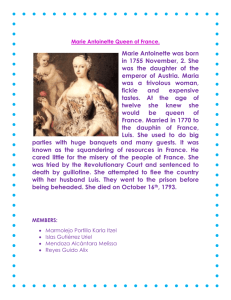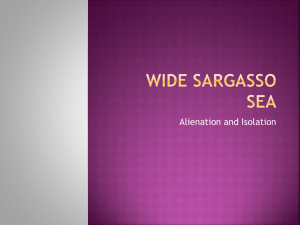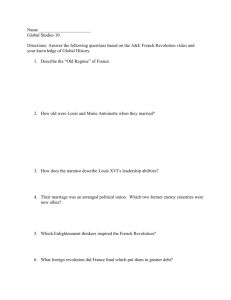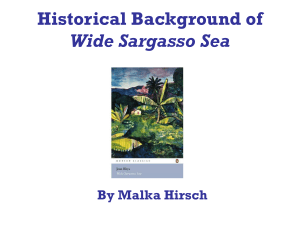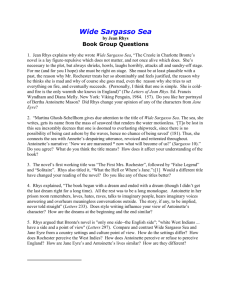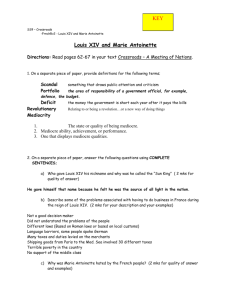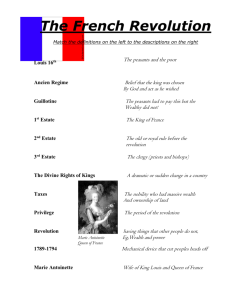Doyle Kelly Doyle Dr. Maxwell ENGL 700 November 20, 2014
advertisement
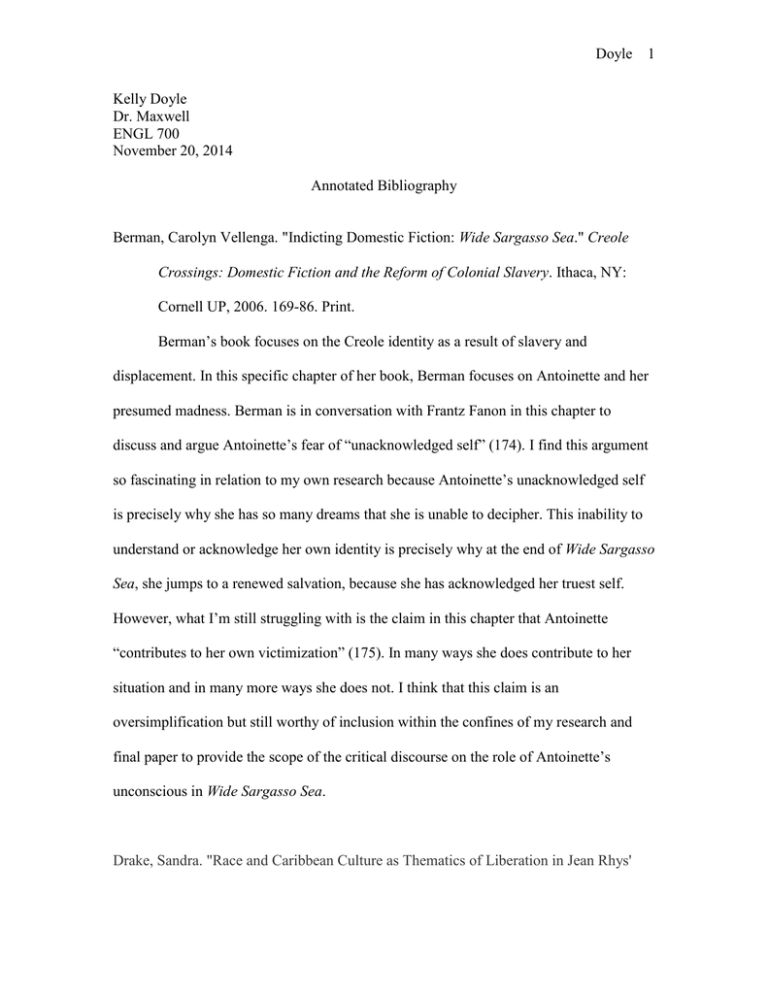
Doyle 1 Kelly Doyle Dr. Maxwell ENGL 700 November 20, 2014 Annotated Bibliography Berman, Carolyn Vellenga. "Indicting Domestic Fiction: Wide Sargasso Sea." Creole Crossings: Domestic Fiction and the Reform of Colonial Slavery. Ithaca, NY: Cornell UP, 2006. 169-86. Print. Berman’s book focuses on the Creole identity as a result of slavery and displacement. In this specific chapter of her book, Berman focuses on Antoinette and her presumed madness. Berman is in conversation with Frantz Fanon in this chapter to discuss and argue Antoinette’s fear of “unacknowledged self” (174). I find this argument so fascinating in relation to my own research because Antoinette’s unacknowledged self is precisely why she has so many dreams that she is unable to decipher. This inability to understand or acknowledge her own identity is precisely why at the end of Wide Sargasso Sea, she jumps to a renewed salvation, because she has acknowledged her truest self. However, what I’m still struggling with is the claim in this chapter that Antoinette “contributes to her own victimization” (175). In many ways she does contribute to her situation and in many more ways she does not. I think that this claim is an oversimplification but still worthy of inclusion within the confines of my research and final paper to provide the scope of the critical discourse on the role of Antoinette’s unconscious in Wide Sargasso Sea. Drake, Sandra. "Race and Caribbean Culture as Thematics of Liberation in Jean Rhys' Doyle 2 Wide Sargasso Sea." Wide Sargasso Sea. By Jean Rhys. New York: Norton, 1999. 193-206. Print. What I found most compelling about Drake’s article was her lengthy discussion about Antoinette’s “real” death in the Caribbean versus her actual physical death in England. Drake also brings in the concept of zombi and how Antoinette could function as a zombi figure after her “real” death. Drake argues that Antoinette’s real death is her relationship with Rochester and what he represents: colonization. Her existence as a zombi, as Drake argues, is evidenced through her dream sequences and through her “real” death. Drake also interprets Antoinette’s physical death at the end of the novel as the African belief in the community of the dead and the belief that after a physical death, the soul will return to the ancestral land. All three of these theories that Drake presents relate to and aid my argument for my final paper because they all focus on the concept of death and what death within the confines of Wide Sargasso Sea symbolizes. Drake presents the idea of the soul returning home but doesn’t explicitly connect it to the myth of flying in the slave culture of the Caribbean or the Americas. However, I believe that this is what she is calling on and I intend to take this idea further to present Antoinette’s final or physical death as both her “real” and spiritual death because of what the myth of flying would represent for Antoinette: going home. Emery, Mary Lou. "The Politics of Form: Jean Rhys's Social Vision in Voyage in the Dark and Wide Sargasso Sea." Twentieth Century Literature 28.4 (1982): 41830.JSTOR. Web. 11 Nov. 2014. Doyle 3 The argument that Emery sets forth in her article is that of Antoinette as a cultural and sexual outsider in the Caribbean and England, the colonial and the postcolonial world. Emery also focuses on the function of Antoinette’s dreams throughout Wide Sargasso Sea and how these dreams affirm Antoinette’s reality and eventual reality. The dreams represent the unspoken, things that cannot or are not spoken but need to be. Emery argues that Antoinette’s jump in the end of Wide Sargasso Sea signifies the literal fulfillment of her own dreams. As Antoinette trusts the reality in her dreams and the fantasy of waking life, the reasoning behind her decision to jump becomes clear. In her dream world, Antoinette is her true self and in jumping she aligns with this truest form of self. The seeming fragmentation of the dreams throughout Wide Sargasso Sea actually gestures towards Antoinette’s fate. The role of sexual and cultural outsider that Antoinette occupies throughout the novel is diminished through her final act towards escape. I plan to use Emery’s article to focus on the dream imagery throughout the novel and how these dreams point to both Antoinette’s fears and the reality that she is unable or incapable of confronting. While I think that the ending of the novel is more than just Antoinette’s alignment with the prophecies of her dreams, I do think that this aspect of the text is important to discuss within my paper to point towards why this interpretation is compelling but still not entirely satisfying. Gates, Henry Louis. "The Vernacular Tradition." Introduction. The Norton Anthology of African American Literature. Ed. Nellie Y. McKay. New York: W.W. Norton, 2003. 3-150. Print. Doyle 4 The discussion of language and the tradition of that language within the displaced African community that Gates presents in this introduction are necessary for my continued understanding of the function of folklore and the legend of flight. Included in this section are spirituals, work songs, and folktales that offer a more complete view of the oral tradition in African communities and specifically displaced African communities. This section offers examples of the legend or myth of flight through specific folktales and songs that are important to perhaps include in my paper to provide examples of these legends and how they fit within the confines of Wide Sargasso Sea. While these folktales and songs are categorized as African American, they offer a view into the oral tradition of the diaspora that aids in my understanding of the function of these types of tales. Gregg, Veronica Marie. Jean Rhys's Historical Imagination: Reading and Writing the Creole. Chapel Hill: U of North Carolina, 1995. Print. Gregg’s book is an invaluable resource for my research because it provides key historical and background information about the Caribbean while linking this history specifically to Rhys’s literary works. The interpretation Gregg offers of Wide Sargasso Sea and Antoinette’s relationship to Tia has forced me to look more closely at Rhys’s use of foreshadowing throughout the novel. For example, Gregg notes how Tia and Antoinette’s encounter the night Coulibri burns foreshadows Antoinette’s final moments at Thornfield Hall. Gregg also goes on to discuss how Antoinette’s dreams function as foreshadowing for this ending as well. This text has allowed me to view Wide Sargasso Sea in a greater and deeper historical and cultural sense that will benefit my research and Doyle 5 final paper. By placing Antoinette more firmly in relation to her island culture, Gregg asserts Antoinette’s connection to these islands and ultimately to Tia. Halloran, Vivian Nun. "Race, Creole, and National Identities in Rhys's Wide Sargasso Sea and Phillips's Cambridge." Small Axe: A Caribbean Journal of Criticism 21 (2006): 87-104. JSTOR. Web. 14 Nov. 2014. What interests me most about Halloran’s article as it relates to my final paper is her discussion of Tia and Antoinette and white versus black identity in the Caribbean. She incorporates W. E. B. Du Bois’s concept of “double consciousness” to connect Tia and Antoinette, which is something I hadn’t previously considered but is compelling in relation to my own argument. Halloran goes on to discuss how Tia and Antoinette mimic each other verbally in their encounters and how this reflects the connection between them that they are unable to perceive. Both girls attempt to put down the other through racial or economic means and yet they fail to realize that these means are the bond between them. I find Halloran’s article impactful in relation to my own argument about Antoinette’s final moments in Wide Sargasso Sea. The link between Tia and Antoinette is a crucial aspect of the novel and Halloran’s argument about the economic and social standing of each girl sheds valuable insight on Antoinette’s desire to connect with Tia, and what Tia represents for Antoinette in her final moments. Halloran also makes a claim about the racial identity of Antoinette that I want to explore further in my consideration of Antoinette as a woman of color as opposed to the reading of her as a white islander. Doyle 6 Spivak, Gayatri Chakravorty. "Three Women's Texts and a Critique of Imperialism.” Critical Inquiry 12.1 (1985): 243-61. JSTOR. Web. 15 Nov. 2014. Spivak’s focus on the impact of imperialism in this article chiefly involves the specific ways in which imperialism impacts identity and personality. While he focuses a great deal on Jane Eyre and Frankenstein, which for the purposes of this paper I won’t necessarily need, his interpretation of these texts in relation to imperialism are still altogether helpful in determining his aim and argument in the article. His most compelling argument for the purposes of my own paper is the concept of mirroring in Wide Sargasso Sea through both Antoinette’s dreams and her relationship with Tia. While I find the concept of mirroring within Wide Sargasso Sea interesting I don’t think this interpretation takes the relationship with Tia far enough. What I think Spivak is missing is Antoinette’s desire to connect with Tia on a familial level and Antoinette’s racial identity. Spivak interprets the ending of Wide Sargasso Sea as, “an allegory of the general epistemic violence of imperialism, the construction of a self-immolating colonial subject for the glorification of the social mission of the colonizer” (251). I completely disagree with this interpretation and instead view Antoinette’s final fate as a salvation, a complete escape from the confines of colonialism, not dying at the hands colonialism as Spivak suggests. I intend to use Spivak’s article as a way to introduce the critical discussion of the relationship between Tia and Antoinette, the interpretation of other key critics, and my own interpretation of their important relationship. Doyle 7 Wilentz, Gay. "If You Surrender to the Air: Folk Legends of Flight and Resistance in African American Literature." MELUS 16.1 (1989): 21-32. JSTOR. Web. 15 Nov. 2014. Wilentz’s article offers a compelling approach to the African folk legend of flight as a form of salvation, or a personal choice for freedom. She discusses this myth of flight as a group or communities ability to collectively represent transcendence from one physical state. Wilentz additionally approaches this topic by discussing retention of culture in the displaced African slave community and also the function of the collective unconscious. While the title of this article would point towards a chiefly African American focus on the legend of flight, I found this article helpful because Wilentz definitively states the pervasiveness of the legend throughout the United States and the Caribbean. While Wilentz does focus on African American texts while I will focus on a Caribbean text in my research, much can be extracted from this information. Additionally, the analysis of the importance of this legend is integral to my understanding of the legend of flight and serves as a crucial starting point to researching this topic. I plan to use this article in my paper to provide a definition of this myth and why it is important within the context of the Caribbean, slavery, and post colonialism. Wilentz also quotes from the folktales themselves and her research on the folktales in their various forms has led me to some key slave songs and folktales that I think are necessary to include in my paper.
